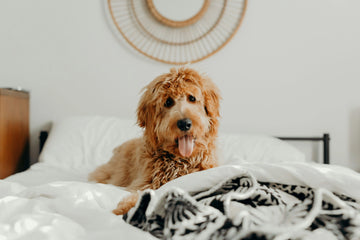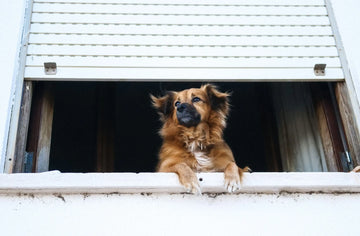Blog
Dog Pee on My Bed: When Your Furry Friend Turns Your Mattress into a Toilet
by
BrownLisa
on
Jan 31, 2025
It's been a long day, and all you want is to collapse into bed. But as you pull back the covers, your fingers brush against an unexpected damp patch. You turn to see your dog curled up at the foot of the bed, giving you that "cosmic-level innocent" look, tail wagging slowly as if to say, “It was an accident… believe me, right?”
This isn’t the opening scene of a horror movie—it’s a reality many pet owners face.
I. The Science Behind Dog Pee on My Bed: Top 5 Causes
1. Health Red Flags: Your Dog’s Body is Sending an SOS
-Urinary Tract Issues
Conditions like urinary infections, bladder stones, diabetes, or Cushing’s disease can lead to frequent urination, urgency, or even incontinence. If your dog shows signs of straining, blood in their urine, or cloudy urine, a vet visit within 24 hours is crucial.
Dogs over seven may experience weakened sphincter muscles or cognitive dysfunction syndrome (CDS), similar to early-stage Alzheimer’s in humans, causing them to "forget" they need to go.

2. Behavioural Clues: Emotions Overrule Bladder Control
-Anxiety-Induced Accidents
-Territorial Marking
Unneutered male dogs may mark their territory with urine when encountering new pets or people, as their urine contains three times more pheromones than neutered dogs.
-Excitement Leakage
Puppies under one year may involuntarily urinate when excited due to underdeveloped nervous systems, though this usually resolves with age.
3. Environmental Misunderstanding
If urine stains aren’t thoroughly cleaned, residual urea crystals (detectable by dogs at concentrations as low as 1ppm) can attract repeat marking, reinforcing the idea that "this spot = toilet."

II. The 4-Step Plan to Stop Dog Pee on My Bed
Step 1: The 48-Hour Golden Window
-Create an observation checklist to monitor your dog’s behaviour.
Morning: Frequent urination, 5+ times per hour, with small amounts of urine. The pet exhibits licking of the lower abdomen.Night: Urination occurs twice, with larger amounts of urine, and no abnormal symptoms are observed.
If abnormalities persist beyond 30% of the time, consult a vet immediately.
-Basic tests to request:
Urinalysis (check for crystals or bacteria)
Blood biochemistry (assess kidney and liver health)
Abdominal ultrasound (detect bladder stones)

Step 2: The Odour Elimination Mission
1. Choosing the Right Cleaner:
Enzyme-based + pH 5.5-6.5 (optimal for breaking down urea) + ammonia-free formula = 98% effective removal rate.
✖ Avoid bleach (reacts with urine to release irritating chlorine gas).
2. Step-by-Step Cleaning:
-Blot the surface with paper towels.
-Soak the area with enzyme cleaner.
-Cover with cling film for two hours to enhance breakdown.
-Rinse with cold water (hot water can set protein stains).
Step 3: Behavioural Retraining
1. Scheduled Potty Breaks:
Puppies (2-6 months): Should be guided every 2 hours, with the best times being 10 minutes after waking up or eating.
Adult Dogs: Should be guided every 6 hours, with the optimal times at 7 AM, 1 PM, and 8 PM.
2.Positive Reinforcement:
-Offer a treat within 3 seconds of correct urination (delayed rewards lose effectiveness).
-Use a high-pitched “Good job!”
Step 4: Environmental Adjustments
1. Space Management:
-Use baby gates to restrict bedroom access.
2. Anxiety Solutions:
-Try pheromone diffusers (mimic calming maternal scents).
-Leave interactive toys like treat-dispensing balls.

III. FAQ
Q1: Will Neutering Stop My Dog from Peeing on My Bed?
A: The stats: Neutering reduces marking behavior in male dogs by 71%, but it won’t address medical or anxiety-related issues. Consider hormone testing before surgery.
Q2: Does Punishment Make Things Worse?
A: The science: Dogs have only 10% of the prefrontal cortex capacity of humans, meaning they can’t connect punishment to past actions. Scolding may lead to stress-induced incontinence, creating a vicious cycle.
Q3: Will Urine Stains Attract Other Dogs?
A: Behavioural insight: In multi-dog households, the first dog’s marking can trigger others to follow suit. Clean thoroughly and train the "lead dog" individually.
IV. Final Thoughts: Understanding is Key
When the sheets face another "accident," remember, your dog isn’t trying to misbehave or get revenge. Their urinary system is far more fragile than ours, and their actions are often driven by instinct or health issues. Accidents are usually a signal—your dog might be feeling unwell or stressed. As a pet owner, it’s our job to decode these signals and help them with patience and care.
Next time you find a "crime scene," take a deep breath and respond with understanding, not frustration. Your dog is simply saying, "I need your help."
And don’t forget to give them a warm hug—after all, they just want a more comfortable "bathroom."
Please note: The above content is for reference only and should not replace professional veterinary advice.










